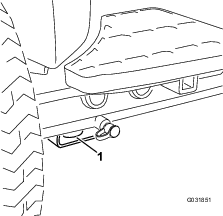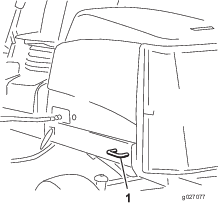| Maintenance Service Interval | Maintenance Procedure |
|---|---|
| Before each use or daily |
|
Introduction
This machine is a ride-on, reel-blade lawn mower intended to be used by professional, hired operators in commercial applications. It is primarily designed for cutting grass on well-maintained turf.
Read this information carefully to learn how to operate and maintain your product properly and to avoid injury and product damage. You are responsible for operating the product properly and safely.
Visit www.Toro.com for more information, including safety tips, training materials, accessory information, help finding a dealer, or to register your product.
Whenever you need service, genuine Toro parts, or additional information, contact an Authorized Service Dealer or Toro Customer Service and have the model and serial numbers of your product ready. Figure 1 identifies the location of the model and serial numbers on the product. Write the numbers in the space provided.
Important: With your mobile device, you can scan the QR code on the serial number plate (if equipped) to access warranty, parts, and other product information.
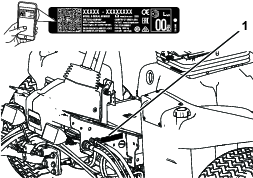
This manual identifies potential hazards and has safety messages identified by the safety-alert symbol (Figure 2), which signals a hazard that may cause serious injury or death if you do not follow the recommended precautions.

This manual uses 2 words to highlight information. Important calls attention to special mechanical information and Note emphasizes general information worthy of special attention.
This product complies with all relevant European directives. For details, please see the separate product specific Declaration of Conformity (DOC) sheet.
It is a violation of California Public Resource Code Section 4442 or 4443 to use or operate the engine on any forest-covered, brush-covered, or grass-covered land unless the engine is equipped with a spark arrester, as defined in Section 4442, maintained in effective working order or the engine is constructed, equipped, and maintained for the prevention of fire.
The enclosed engine owner’s manual is supplied for information regarding the US Environmental Protection Agency (EPA) and the California Emission Control Regulation of emission systems, maintenance, and warranty. Replacements may be ordered through the engine manufacturer.
Warning
CALIFORNIA
Proposition 65 Warning
Diesel engine exhaust and some of its constituents are known to the State of California to cause cancer, birth defects, and other reproductive harm.
Battery posts, terminals, and related accessories contain lead and lead compounds, chemicals known to the State of California to cause cancer and reproductive harm. Wash hands after handling.
Use of this product may cause exposure to chemicals known to the State of California to cause cancer, birth defects, or other reproductive harm.
Safety
This machine has been designed in accordance with EN ISO 5395:2013.
General Safety
This product is capable of amputating hands and feet and of throwing objects.
Using this product for purposes other than its intended use could prove dangerous to you and bystanders.
-
Read and understand the contents of this Operator’s Manual before starting the engine.
-
Use your full attention while operating the machine. Do not engage in any activity that causes distractions; otherwise, injury or property damage may occur.
-
Do not put your hands or feet near moving components of the machine.
-
Do not operate the machine without all guards and other safety protective devices in place and functioning properly on the machine.
-
Keep children, bystanders, and pets out of the operating area. Never allow children to operate the machine.
-
Always shut off the engine, remove the key (if equipped), wait for all moving parts to stop, and allow the machine to cool before adjusting, servicing, cleaning, or storing the machine.
Improperly using or maintaining this machine can result in injury.
To reduce the potential for injury, comply with these safety instructions
and always pay attention to the safety-alert symbol  , which means
Caution, Warning, or Danger—personal safety instruction. Failure
to comply with these instructions may result in personal injury or
death.
, which means
Caution, Warning, or Danger—personal safety instruction. Failure
to comply with these instructions may result in personal injury or
death.
Safety and Instructional Decals
 |
Safety decals and instructions are easily visible to the operator and are located near any area of potential danger. Replace any decal that is damaged or missing. |



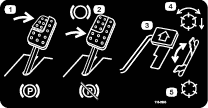
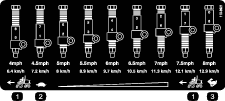

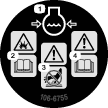



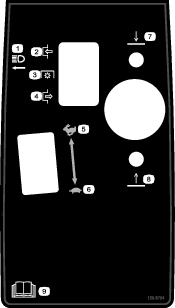
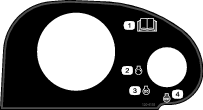



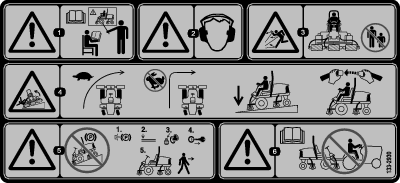

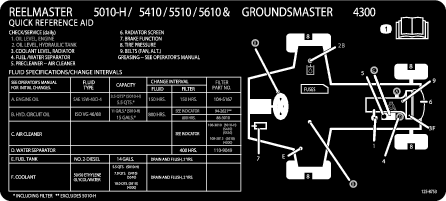
Setup
Note: Determine the left and right sides of the machine from the normal operating position.
Adjusting the Tire Pressure
The tires are over-inflated for shipping. Therefore, release some of the air to reduce the pressure. Correct air pressure in the front and rear tires is 83 to 103 kPa (12 to 15 psi).
Important: Maintain even pressure in all tires to ensure uniform contact with the turf.
Adjusting the Control-Arm Position
The control-arm position can be adjusted for your comfort.
-
Loosen the 2 bolts securing the control arm to the retaining bracket (Figure 3).
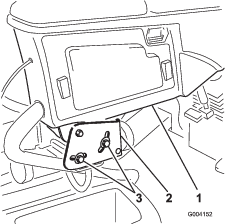
-
Rotate the control arm to the desired position and tighten the 2 bolts.
Installing the Cutting Units
Parts needed for this procedure:
| Cutting units | 5 |
Caution
If you do not disconnect the power to the cutting units, someone could accidentally start the cutting unit, causing serious injury to hands and feet.
Always separate the power-disconnect connectors before working on the cutting units (Figure 27).
-
Disconnect the power-disconnect connector; refer to Cutting-Unit-Power Disconnect.
-
Remove the cutting units from the cartons. Assemble and adjust as described in the cutting unit Operator's Manual.
-
Make sure that the counter weight (Figure 4) is installed to the proper end of the cutting unit as described in the counter weight kit Installation Instructions.
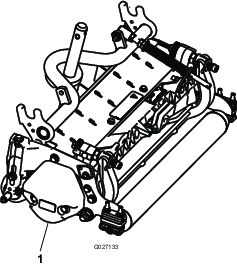
-
Mount the turf-compensation spring to the same side of the cutting unit as the reel-drive motor. Position the turf compensation as follows:
Note: All cutting units are shipped with the turf-compensation spring mounted to the right side of the cutting unit.
-
Remove the 2 carriage bolts and nuts securing the rod bracket to the cutting-unit tabs (Figure 5).

-
Remove the flange nut securing the spring tube bolt to the carrier-frame tab (Figure 5) Remove the assembly.
-
Mount the spring-tube bolt to the opposite tab on the carrier frame and secure with the flange nut.
Note: Position to the bolt head to the outer side of the tab as shown in Figure 6.

-
Mount the rod bracket to the cutting-unit tabs with the carriage bolts and nuts (Figure 6).
Note: When installing or removing the cutting units, make sure that the hairpin cotter is installed in the spring rod hole next to the rod bracket. Otherwise, install the hairpin cotter in the hole in the end of the rod.
-
-
Lower all lift arms completely.
-
Remove the snapper pin and the cap from the lift arm pivot yoke (Figure 7).
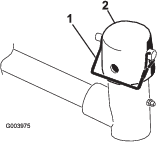
-
For the front cutting units, slide a cutting unit under the lift arm while inserting the carrier-frame shaft up into the lift-arm-pivot yoke (Figure 8).
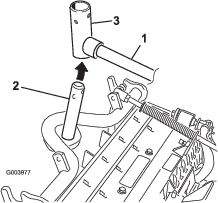
-
Use the following procedure on the rear cutting units when the height of cut is above 19 mm (3/4 inch).
-
Remove the lynch pin and washer securing the lift-arm-pivot shaft to the lift arm and slide the lift-arm-pivot shaft out of the lift arm (Figure 9).
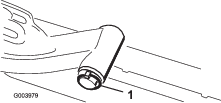
-
Insert the lift-arm yoke onto the carrier-frame shaft (Figure 8).
-
Insert the lift-arm shaft into the lift arm and secure it with the washer and lynch pin (Figure 9).
-
-
Insert the cap over the carrier-frame shaft and lift-arm yoke.
-
Secure the cap and the carrier-frame shaft to the lift-arm yoke with the snapper pin (Figure 7).
Note: Use the slot if a steering cutting unit is desired or use the hole if the cutting unit is to be locked in position.
-
Secure the lift-arm chain to the chain bracket with the snapper pin (Figure 10).
Note: Use the number of chain links described in the cutting unit Operator's Manual.
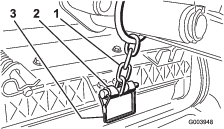
-
Coat the spline shaft of the reel motor with clean grease.
-
Oil the reel motor O-ring and install it onto the motor flange.
-
Install the motor by rotating it clockwise so that the motor flanges clear the bolts (Figure 11).
Note: Rotate the motor counterclockwise until the flanges encircle the bolts and then tighten the bolts.
Important: Make sure that the reel-motor hose is not twisted, kinked or in the risk of being pinched.

Mounting the Finishing Kits
Parts needed for this procedure:
| Finishing kit | 1 |
Important: To ensure that the hose routing is appropriate and the hoses are not twisted, mount the motors to the cutting units before mounting the finishing kits.
-
On the front left corner of the frame (no. 4 cutting unit location), remove the extra flange nut on the bolt securing the bulkhead bracket to the machine (Figure 12).
-
Loosen the nuts on the finishing kit hose fitting, insert the hose into the slot on the bulkhead bracket and tighten the nuts.
Note: When tightening the nuts, use a back up wrench to prevent the hose from twisting or kinking.
-
Insert the connector plate onto the bulkhead-mounting bolts with the connectors positioned as shown in Figure 12.
-
Secure the connector plate to 1 of the mounting bolts with the flange nut previously removed.
-
Locate the wire harness on the machine and plug the wire connectors into the wire connectors of the finishing kit.

-
Repeat the procedure on the remaining 4 bulkhead locations as shown in Figure 13 through Figure 16.
Important: The connector plates are positioned differently at the remaining locations so the hose can be routed through the bulkhead bracket and to the cutting unit without getting twisted or kinked.
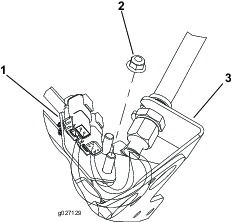
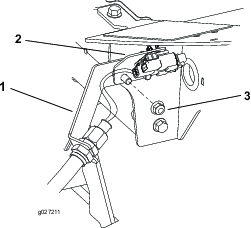

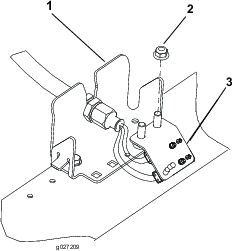
Adjusting the Turf-Compensation Spring
The turf-compensation spring (Figure 17) transfers the weight from the front to the rear roller. This helps to reduce a wave pattern in the turf, also known as marcelling or bobbing.
Important: Make spring adjustments with the cutting unit mounted to the traction unit, pointing straight ahead and lowered to the ground.
-
Make sure that the hairpin cotter is installed in the rear hole in the spring rod (Figure 17).
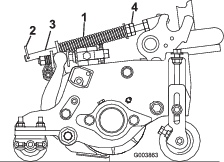
-
Tighten the hex nuts on the front end of the spring rod until the compressed length of the spring is 12.7 cm (5 inches) for 5-inch cutting units or 15.9 cm (6.25 inches) for 7-inch cutting units (Figure 17).
Note: When operating on rough terrain decrease the spring length by 12.7 mm (1/2 inch). Ground following will be slightly decreased.
Installing the CE Hood Latch
Parts needed for this procedure:
| Hood-latch assembly | 1 |
| Washer | 1 |
-
Unlatch and raise the hood.
-
Remove the rubber grommet from the hole in the left side of the hood (Figure 18).
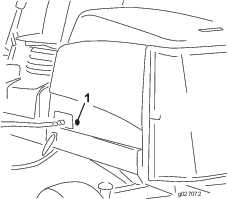
-
Remove the nut from the hood-latch assembly (Figure 19).
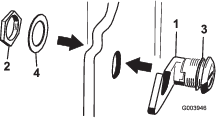
-
Outside the hood, insert the hook end of the latch through the hole in the hood. Make sure that the rubber sealing washer remains on the outside of the hood.
-
Inside the hood, insert the metal washer onto the latch and secure with the nut. Make sure that the latch engages the frame catch when it is locked. Use the enclosed hood-latch key to operate the hood latch.
Using the Cutting-Unit Kickstand
Parts needed for this procedure:
| Cutting-unit kickstand | 1 |
Whenever you need to tip the cutting unit to expose the bedknife/reel, prop up the rear of the cutting unit with the kickstand to make sure that the nuts on the back end of the bedbar-adjusting screws are not resting on the work surface (Figure 20).
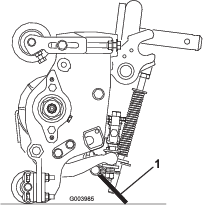
Secure the kickstand to the chain bracket with the snapper pin (Figure 21).
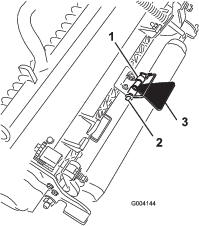
Product Overview
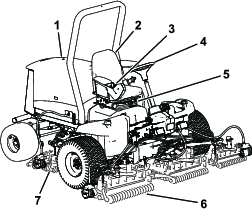
Seat-Adjusting Knobs
The seat-adjusting lever (Figure 23) allows you to adjust the seat fore and aft. The weight-adjusting knob adjusts the seat for your weight. The weight gauge indicates when the seat is adjusted to your weight. The height-adjusting knob adjusts the seat for your height.
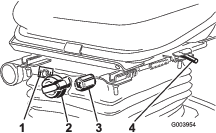
Traction Pedal
The traction pedal (Figure 24) controls the forward and reverse operation. Press the top of the pedal to move forward and the bottom to move rearward. The ground speed depends on how far you press the pedal. For no load, maximum ground speed, fully press the pedal while the throttle is in the FAST position.
To stop the machine, reduce foot pressure on the traction pedal and allow it to return to the center position.
Mow-Speed Limiter
When the mow-speed limiter (Figure 24) is flipped up it controls the mow speed and allows the cutting units to be engaged. Each spacer adjusts the mowing speed by 0.8 km/h (0.5 mph). The more spacers you have, on the top of the bolt the slower you go. For transport, flip back the mow-speed limiter and you will have maximum transport speed.
Note: When mowing in the Economy mode, the mowing ground speed is slightly reduced. Remove 1 spacer to achieve the same mowing speed as when mowing in the normal mode.
Brake Pedal
Press the brake pedal (Figure 24) to stop the machine.
Parking Brake
To engage the parking brake, (Figure 24) push down on the brake pedal and press the top forward to latch. To release the parking brake, press the brake pedal until the parking-brake latch retracts.
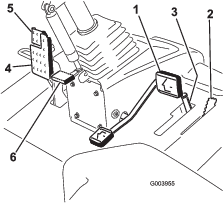
Tilt-Steering Pedal
To tilt the steering wheel toward you, press the foot pedal (Figure 24) down, pull the steering tower toward you to the most comfortable position, and then release the pedal.
Engine-Speed Switch
The engine-speed switch has 2 modes to change the engine speed (Figure 25). By momentarily tapping the switch, you can change the engine speed in 100 rpm increments. If you hold the switch down, the engine automatically moves to High or Low idle, depending on which end of the switch you press.
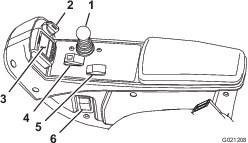
Key Switch
The key switch (Figure 25) has 3 positions: OFF, ON/PREHEAT, and START.
Lower Mow/Raise Control Lever
This lever (Figure 25) raises and lowers the cutting units and also starts and stops the cutting units when the cutting units are enabled in the MOW mode. You cannot lower the cutting units when the mow/transport lever is in the TRANSPORT position.
Headlight Switch
Pivot the switch downward to turn on the headlights (Figure 25).
Enable/Disable Switch
Use the enable/disable switch (Figure 25) in conjunction with the lower mow/raise control lever to operate the cutting units.
Power Point
The power point is a 12 V power supply for electronic devices (Figure 26).
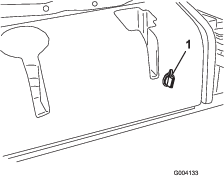
Cutting-Unit-Power Disconnect
Before installing, removing, or working on the cutting units, disconnect the cutting units from the power supply by separating the cutting-unit-power-disconnect connector (Figure 27), located under the seat. Plug the connector back in before operating the machine.
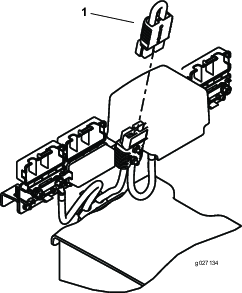
Caution
If you do not disconnect the power to the cutting units, someone could accidentally start the cutting unit, causing serious injury to hands and feet.
Always separate the cutting-unit-power-disconnect connectors before working on the cutting units.
Using the InfoCenter LCD Display
The InfoCenter LCD display shows information about your machine such as the operating status, various diagnostics and other information about the machine (Figure 28). There are multiple display screens on the InfoCenter. You can switch between the screens, at any time, by pressing any of the InfoCenter buttons and then selecting the appropriate directional arrow.
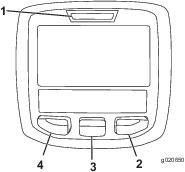
-
Left Button, Menu Access/Back Button— Press this button to access the InfoCenter menus. You can use it to back out of any menu you are currently using.
-
Middle Button— Press this button to scroll down menus.
-
Right Button— Press this button to open a menu where a right arrow indicates additional content.
Note: The purpose of each button may change depending on what is required at the time. Each button is labeled with an icon displaying its current function.
| SERVICE DUE | Indicates when scheduled service should be performed |
 | Hour meter |
 | Info icon |
 | Fast |
 | Slow |
 | Fuel level |
 | The glow plugs are active. |
 | Raise the cutting units. |
 | Lower the cutting units. |
 | Sit in the seat. |
 | The parking brake is on. |
 | The range is high (transport). |
 | Neutral |
 | The range is low (mow). |
 | Engine-coolant temperature (°C or °F) |
 | Temperature (hot) |
 | The PTO is engaged. |
 | Not allowed |
 | Start the engine. |
 | Stop the engine. |
 | Engine |
 | Key switch |
 | Battery |
 | Motor/Generator (not charging) |
 | Motor/Generator (charging) |
 | E-Reel |
 | Front Backlap |
 | Rear Backlap |
 | The cutting units are lowering. |
 | The cutting units are raising. |
 | PIN passcode |
 | CAN bus |
 | InfoCenter |
 | Bad or failed |
 | Bulb |
 | Output of TEC controller or control wire in harness |
 | Switch |
 | Release the switch. |
 | Change to the indicated state. |
| Symbols are often combined to form sentences. Some examples are shown below | |
 | Put the machine into Neutral. |
 | Engine start is denied. |
 | Engine shutdown |
 | Engine coolant is too hot. |
 | Sit down or set parking brake |
Using the Menus
To access the InfoCenter menu system, press the menu access button while at the main screen. This brings you to the main menu. Refer to the following tables for a synopsis of the options available from the menus:
| Main Menu | |
| Menu Item | Description |
| Faults | The Faults menu contains a list of the recent machine faults. Refer to the Service Manual or contact your Toro Distributor for more information on the Faults menu and the information contained there. |
| Service | The Service menu contains information on the machine such as hours of use, counters, and other similar numbers. |
| Diagnostics | The Diagnostics menu displays the state of each machine switch, sensor, and control output. You can use this to troubleshoot certain issues as it quickly tells you which machine controls are on and which are off. |
| Settings | The Settings menu allows you to customize and modify configuration variables on the InfoCenter display. |
| About | The About menu lists the model number, serial number, and software version of your machine. |
| Service | |
| Menu Item | Description |
| Hours | Lists the total number of hours that the machine, engine and PTO have been on, as well as the number of hours the machine has been transported and service due. |
| Counts | Lists numerous counts the machine has experienced. |
| Diagnostics | |
| Menu Item | Description |
| Cutting Units | Indicates the inputs, qualifiers, and outputs for raising and lowering the cutting units. |
| Hi/Low Range | Indicates the inputs, qualifiers, and outputs for driving in transport mode. |
| PTO | Indicates the inputs, qualifiers, and outputs for enabling the PTO circuit. |
| Engine Run | Indicates the inputs, qualifiers, and outputs for starting the engine. |
| Backlap | Indicates the inputs, qualifiers and outputs for operating the backlap function. |
| Settings | |
| Menu Item | Description |
| Units | Controls the units used on the InfoCenter. The menu choices are English or Metric. |
| Language | Controls the language used on the InfoCenter*. |
| LCD Backlight | Controls the brightness of the LCD display. |
| LCD Contrast | Controls the contrast of the LCD display. |
| Front Backlap Reel Speed | Controls the speed of the front reels in backlap mode. |
| Rear Backlap Reel Speed | Controls the speed of the rear reels in backlap mode. |
| Protected Menus | Allows the superintendant/mechanic to access protected menus by inputting a passcode. |
| Auto Idle | Controls the amount of time allowed before returning the engine to low idle when the machine is stationary. |
| Blade Count | Controls the number of blades on the reel for reel speed. |
| Mow Speed | Controls the ground speed for determining the reel speed. |
| Height of cut (HOC) | Controls the height of cut (HOC) for determining the reel speed. |
| F Reel RPM | Displays the calculated reel speed position for the front reels. The reels can also be manually adjusted. |
| R Reel RPM | Displays the calculated reel speed position for the rear reels. The reels can also be manually adjusted. |
| Economy Mode | When activated, the Economy Mode lowers the engine speed while mowing to reduce noise and fuel consumption. The reel speed does not change, but the mow speed is decreased if the mow stop is not adjusted accordingly. |
*Only "operator-faced" text is translated. Faults, Service, and Diagnostics screens are "service-faced.” Titles are in the selected language, but menu items are in English.
| About | |
| Menu Item | Description |
| Model | Lists the model number of the machine. |
| SN | Lists the serial number of the machine. |
| Machine Controller Revision | Lists the software revision of the master controller. |
| CU 1CU 2CU 3CU 4CU 5 | Lists the software revision of each cutting unit. |
| Generator | Lists the software revision of the motor/generator. |
| InfoCenter Revision | Lists the software revision of the InfoCenter. |
| CAN Bus | Lists the machine communication bus status. |
Protected Menus
There are 2 additional display screens and 7 operating configuration settings that are adjustable within the Settings Menu of the InfoCenter: Auto Idle, Blade Count, Mow Speed, Height of Cut (HOC), F Reel RPM, R Reel RPM, and Economy Mode. These settings can be locked by using the Protected Menu.
Note: At the time of delivery, the initial password code is programmed by your distributor.
Accessing the Protected Menu Settings and Display Screens
To access the Protected Menu Settings and Display Screens
-
From the Main Menu, scroll down to the Settings Menu and press the right button.
-
In the Settings Menu, scroll down to the Protected Menu and press the right button.
-
To enter the passcode, use the center button to set the first digit then press the right button to move on to the next digit.
-
Use the center button to set the second digit then press the right button to move on to the next digit.
-
Use the center button to set the third digit then press the right button to move on to the next digit.
-
Use the center button to set the fourth digit then press the right button.
-
Press the middle button to enter the code.
-
If the code has been accepted and the protected menu has been unlocked, “PIN” is be displayed in the upper right corner of the display screen.
Note: If the passcode has been forgotten or misplaced, please contact your distributor for assistance.
Viewing and Changing the Protected Menu Settings
-
In the Protected Menu, scroll down to Protect Settings.
-
To view and change the settings without entering a passcode, use the right button to change the Protect Settings to OFF.
-
To view and change the settings with a passcode, use the left button to change the Protect Settings to ON, set the passcode, and turn the key in the ignition switch to the OFF position and then to the ON position.
Setting the Auto Idle
-
In the Settings Menu, scroll down to Auto Idle.
-
Press the right button to change the auto idle time between OFF, 8S, 10S, 15S, 20S, and 30S.
Setting the Blade Count
-
In the Settings Menu, scroll down to Blade Count
-
Press the right button to change the blade count between 5, 8 or 11 blade reels.
Setting the Mow Speed
-
In the Settings Menu, scroll down to Mow Speed.
-
Press the right button to select Mow Speed.
-
Use the center and right button to select the appropriate mow speed set on the mechanical mow-speed limiter on the traction pedal.
-
Press the left button to exit mow speed and save the setting.
Setting the Height of Cut (HOC)
-
In the Settings Menu, scroll down to HOC.
-
Press the right button to select HOC.
-
Use the center and right button to select the appropriate HOC setting. (If the exact setting is not displayed, select the nearest HOC setting from the list displayed).
-
Press the left button to exit HOC and save the setting.
Setting the Front and Rear Reel Speeds
Although the front and rear reel speeds are calculated by inputting the number of blades, mow speed and HOC into the InfoCenter, the setting can be manually changed to accommodate for different mowing conditions.
-
To change the Reel Speed Settings, scroll down to the F Reel RPM, R Reel RPM, or both.
-
Press the right button to change the reel speed value. As the speed setting is changed, the display continues to show the calculated reel speed based on blade count, mow speed and HOC which was previously entered, but the new value also is displayed.
Setting the Economy Mode
-
From the Main Menu, use the center button to scroll down to the Settings Menu.
-
Press the right button to select.
-
In the Settings Menu, use the center button to scroll down to the Economy Mode.
-
Press the right button to select the ON function.
-
Press the left button to save the setting and exit the settings.
To Access Protected Display Screens
From the main screen, press the center button once, when the arrows appear above the buttons, press the center button again to scroll through the display screens.
Press the center button again to access the eReel information screen displaying the reel current and the speed for each of the 5 cutting units.
Press the center button again to access the energy mode screen displaying the components, energy flow and the direction while in operation.
Note: Specifications and design are subject to change without notice.
| Transport Width | 228 cm (90 inches) |
| Width of cut | 254 cm (100 inches) |
| Length | 282 cm (111 inches) |
| Height w/ ROPS | 160 cm (63 inches) |
| Weight | 1259 kg (2,776 lb) |
| Engine | Kubota 24.8 hp |
| Fuel tank capacity | 53 L (14 US gallons) |
| Transport speed | 0 to 16 km/h (0 to 10 mph) |
| Mowing speed | 0 to 13 km/h (0 to 8 mph) |
Attachments/Accessories
A selection of Toro approved attachments and accessories is available for use with the machine to enhance and expand its capabilities. Contact your Authorized Service Dealer or authorized Toro distributor or go to www.Toro.com for a list of all approved attachments and accessories.
To ensure optimum performance and continued safety certification of the machine, use only genuine Toro replacement parts and accessories. Replacement parts and accessories made by other manufacturers could be dangerous, and such use could void the product warranty.
Operation
Note: Determine the left and right sides of the machine from the normal operating position.
Before Operation
Before Operation Safety
General Safety
-
Never allow children or untrained people to operate or service the machine. Local regulations may restrict the age of the operator. The owner is responsible for training all operators and mechanics.
-
Become familiar with the safe operation of the equipment, operator controls, and safety signs.
-
Always shut off the engine, remove the key, wait for all moving parts to stop, and allow the machine to cool before adjusting, servicing, cleaning, or storing the machine.
-
Know how to stop the machine and shut off the engine quickly.
-
Do not operate the machine without all guards and other safety protective devices in place and functioning properly on the machine.
-
Before mowing, always inspect the machine to ensure that the cutting units are in good working condition.
-
Inspect the area where you will use the machine and remove all objects that the machine could throw.
Fuel Safety
-
Use extreme care in handling fuel. It is flammable and its vapors are explosive.
-
Extinguish all cigarettes, cigars, pipes, and other sources of ignition.
-
Use only an approved fuel container.
-
Do not remove the fuel cap or fill the fuel tank while the engine is running or hot.
-
Do not add or drain fuel in an enclosed space.
-
Do not store the machine or fuel container where there is an open flame, spark, or pilot light, such as on a water heater or other appliance.
-
If you spill fuel, do not attempt to start the engine; avoid creating any source of ignition until the fuel vapors have dissipated.
Checking the Engine-Oil Level
The engine is shipped with oil in the crankcase; however, the oil level must be checked before and after the engine is first started.
Crankcase capacity is approximately 3.3 L (3.5 US qt) with the filter.
Use high-quality engine oil that meets the following specifications:
-
API Classification Level Required: CH-4, CI-4 or higher
-
Preferred oil: SAE 15W-40 (above 0°F)
-
Alternate oil: SAE 10W-30 or 5W-30 (all temperatures)
Toro Premium Engine oil is available from your distributor in either 15W-40 or 10W-30 viscosity.
-
Park the machine on a level surface, lower the cutting units, shut off the engine, and remove the key.
-
Open the hood.
-
Remove the dipstick, wipe it clean, and install it (Figure 29).
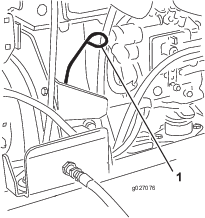
-
Remove the dipstick and check the oil level on the dipstick.
Note: The oil level should be up to the FULL mark.
-
If the oil level is below the FULL mark, remove the fill cap (Figure 30), and add oil until level reaches the FULL mark on the dipstick.

Do not overfill.
Important: Make sure that you keep the engine-oil level between the upper and lower limits on the oil gauge. Engine failure may occur as a result of over filling or under filling the engine oil.
-
Install the oil-fill cap and close the hood.
Filling the Fuel Tank
Fuel Tank Capacity
53 L (14 US gallons)
Fuel Specification
Use only clean, fresh diesel fuel or biodiesel fuels with low (<500 ppm) or ultra low (<15 ppm) sulfur content. The minimum cetane rating should be 40. Purchase fuel in quantities that can be used within 180 days to ensure fuel freshness.
Use summer grade diesel fuel (No. 2-D) at temperatures above -7°C (20°F) and winter grade (No. 1-D or No. 1-D/2-D blend) below that temperature. Use of winter grade fuel at lower temperatures provides lower flash point and cold flow characteristics which eases starting and reduces fuel filter plugging.
Use of summer grade fuel above -7°C (20°F) contributes toward longer fuel pump life and increased power compared to winter grade fuel.
Important: Do not use kerosene or gasoline instead of diesel fuel. Failure to observe this caution damages the engine.
Biodiesel Ready
This machine can also use a biodiesel blended fuel of up to B20 (20% biodiesel, 80% petrodiesel). The petrodiesel portion should be low or ultra low sulfur. Observe the following precautions:
-
The biodiesel portion of the fuel must meet specification ASTM D6751 or EN14214.
-
The blended fuel composition should meet ASTM D975 or EN590.
-
Painted surfaces may be damaged by biodiesel blends.
-
Use B5 (biodiesel content of 5%) or lesser blends in cold weather.
-
Monitor seals, hoses, gaskets in contact with fuel as they may be degraded over time.
-
Fuel filter plugging may be expected for a time after converting to biodiesel blended.
-
Contact your distributor if you wish for more information on biodiesel.
Adding Fuel
-
Park the machine on a level surface, lower the cutting units, shut off the engine, and remove the key.
-
Using a clean rag, clean the area around the fuel-tank cap.
-
Remove the cap from the fuel tank (Figure 31).
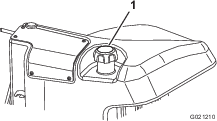
-
Fill the tank until the level is to the bottom of the filler neck with diesel fuel.
-
Install fuel-tank cap tightly after filling tank.
Note: If possible, fill the fuel tank after each use. This minimizes possible buildup of condensation inside the fuel tank.
Checking the Cooling System
| Maintenance Service Interval | Maintenance Procedure |
|---|---|
| Before each use or daily |
|
Clean debris off the screen, oil cooler, and front of the radiator daily and more often if conditions are extremely dusty and dirty. Refer to Removing Debris from the Cooling System.
The cooling system is filled with a 50/50 solution of water and permanent ethylene glycol antifreeze. Check the level of coolant in the expansion tank at the beginning of each day before starting the engine. The capacity of the cooling system is 5.2 L (5.5 US qt).
Caution
If the engine has been running, the pressurized, hot coolant can escape and cause burns.
-
Do not open the radiator cap when the engine is running.
-
Use a rag when opening the radiator cap, and open the cap slowly to allow steam to escape.
-
Check the level of coolant in the expansion tank (Figure 32).
The coolant level should be between the marks on the side of the tank.

-
If the coolant level is low, remove the expansion tank cap and replenish the system. Do not overfill.
-
Install the expansion-tank cap.
Checking the Hydraulic Fluid
| Maintenance Service Interval | Maintenance Procedure |
|---|---|
| Before each use or daily |
|
The machines reservoir is filled at the factory with approximately 41.6 L (11 US gallons) of high-quality hydraulic fluid. Check the level of the hydraulic fluid before the engine is first started and daily thereafter. The recommended replacement fluid is as follows:
| Toro Premium All Season Hydraulic Fluid (Available in 19 L (5 US gallon) pails or 208 L (55 US gallon) drums. See the Parts Catalog or your Toro Distributor for part numbers.) |
Alternate fluids: If the Toro fluid is not available, other fluids may be used provided they meet all the following material properties and industry specifications. We do not recommend the use of synthetic fluid. Consult with your lubricant distributor to identify a satisfactory product.
Note: Toro does not assume responsibility for damage caused by improper substitutions, so use only products from reputable manufacturers who will stand behind their recommendation.
| High Viscosity Index/Low Pour Point Anti-wear Hydraulic Fluid, ISO VG 46 | |||
| Material Properties: | |||
| Viscosity, ASTM D445 | cSt @ 40°C 44 to 48cSt @ 100°C 7.9 to 8.5 | ||
| Viscosity Index ASTM D2270 | 140 to 160 | ||
| Pour Point, ASTM D97 | -36.6°C (-34°F) to 9.4°C (-49°F) | ||
| Industry Specifications: | |||
| Vickers I-286-S (Quality Level), Vickers M-2950-S (Quality Level), Denison HF-0 | |||
Important: The ISO VG 46 Multigrade fluid has been found to offer optimal performance in a wide-range of temperature conditions. For operation in consistently high ambient temperatures, 18°C (65°F) to 49°C (120°F), ISO VG 68 hydraulic fluid may offer improved performance.
Premium Biodegradable Hydraulic Fluid-Mobil EAL EnviroSyn 46H
Important: Mobil EAL EnviroSyn 46H is the only synthetic biodegradable fluid approved by Toro. This fluid is compatible with the elastomers used in Toro hydraulic systems and is suitable for a wide-range of temperature conditions. This fluid is compatible with conventional mineral oils, but for maximum biodegradability and performance the hydraulic system should be thoroughly flushed of conventional fluid. The oil is available in 19 L (5 US gallon) containers or 208 L (55 US gallon) drums from your Mobil Distributor.
Important: Many hydraulic fluids are almost colorless, making it difficult to spot leaks. A red dye additive for the hydraulic system oil is available in 20 ml (2/3 oz) bottles. 1 bottle is sufficient for 15 to 22 L (4 to 6 US gallons) of hydraulic oil. Order Part Number 44-2500 from your Toro Distributor.
-
Park the machine on a level surface, lower the cutting units, shut off the engine, and remove the key.
-
Clean the area around the filler neck and cap of the hydraulic tank (Figure 33).
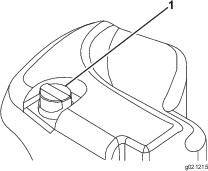
-
Remove the cap/dipstick from the filler neck and wipe it with a clean rag.
-
Insert the dipstick into the filler neck; then remove it and check the level of fluid.
Note: The fluid level should be within the operating range on the dipstick.
Important: Do not overfill.
-
If level is low, add appropriate fluid to raise the level to the FULL mark.
-
Install the cap/dipstick onto the filler neck.
Checking the Reel-to-Bedknife Contact
| Maintenance Service Interval | Maintenance Procedure |
|---|---|
| Before each use or daily |
|
Each day before operating, check the reel-to-bedknife contact, regardless if the quality of cut had previously been acceptable. There must be light contact across the full length of the reel and the bedknife (refer to Adjusting the Reel to Bedknife in the cutting unit Operator's Manual).
Checking the Torque of the Wheel Nuts
| Maintenance Service Interval | Maintenance Procedure |
|---|---|
| After the first hour |
|
| After the first 10 hours |
|
| Every 250 hours |
|
Torque the wheel nuts to 94 to 122 N⋅m (70 to 90 ft-lb).
Warning
Failure to maintain proper torque of the wheel nuts could result in personal injury.
Breaking in the Machine
To ensure optimum performance of the parking brake system, burnish (break in) the brakes before use. Set the forward traction speed to 6.4 km/h (4 mph) to match the reverse traction speed (all 8 spacers moved to the top of the mow-speed control). With the engine at high idle, proceed forward with the mow-speed-control stop engaged and ride the brake for 15 seconds. Proceed backward at full reverse speed and ride the brake for 15 seconds. Repeat this 5 times waiting 1 minute between each forward and reverse cycle to avoid overheating the brakes. An adjustment to the brakes may be required after break-in; refer to Adjusting the Parking Brakes.
Bleeding the Fuel System
You must bleed the fuel system before starting the engine if any of the following situations have occurred:
-
Initial start-up of a new machine.
-
Engine has ceased running due to lack of fuel.
-
Maintenance has been performed upon fuel system components; i.e., filter replaced, separator serviced, etc.
Danger
Under certain conditions, diesel fuel and fuel vapors are highly flammable and explosive. A fire or explosion from fuel can burn you and others and can cause property damage.
-
Use a funnel and fill the fuel tank outdoors, in an open area, when the engine is off and is cold. Wipe up any fuel that spills.
-
Do not fill the fuel tank completely full. Add fuel to the fuel tank until the level is 6 to 13 mm (1/4 to 1/2 inch) below the bottom of the filler neck. This empty space in the tank allows the fuel to expand.
-
Never smoke when handling fuel, and stay away from an open flame or where fuel fumes may be ignited by a spark.
-
Store fuel in a clean, safety-approved container and keep the cap in place.
-
Park the machine on a level surface and ensure that the fuel tank is at least half full.
-
Open the hood.
-
Open the air-bleed screw on the fuel-injection pump (Figure 34) with a 12 mm wrench.
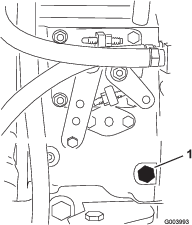
-
Turn the key in the ignition switch to the ON position. The electric fuel pump begins operation, thereby forcing air out around the air bleed screw. Leave the key in the ON position until a solid stream of fuel flows out around the screw.
-
Tighten the screw and turn the key to the OFF position.
Note: Normally, the engine should start after the above bleeding procedures are followed. However, if engine does not start, air may be trapped between injection pump and injectors; refer to Bleeding Air from the Fuel Injectors.
During Operation
During Operation Safety
General Safety
-
The owner/operator can prevent and is responsible for accidents that may cause personal injury or property damage.
-
Wear appropriate clothing, including eye protection; long pants; substantial, slip-resistant footwear; and hearing protection. Tie back long hair and do not wear loose clothing or loose jewelry.
-
Do not operate the machine while ill, tired, or under the influence of alcohol or drugs.
-
Use your full attention while operating the machine. Do not engage in any activity that causes distractions; otherwise, injury or property damage may occur.
-
Before you start the engine, ensure that all drives are in neutral, the parking brake is engaged, and you are in the operating position.
-
Do not carry passengers on the machine and keep bystanders and pets away from the machine during operation.
-
Operate the machine only in good visibility to avoid holes or hidden hazards.
-
Avoid mowing on wet grass. Reduced traction could cause the machine to slide.
-
Keep your hands and feet away from the cutting units.
-
Look behind and down before backing up to be sure of a clear path.
-
Use care when approaching blind corners, shrubs, trees, or other objects that may obscure your vision.
-
Stop the cutting units whenever you are not mowing.
-
Slow down and use caution when making turns and crossing roads and sidewalks with the machine. Always yield the right-of-way.
-
Never run an engine in an area where exhaust gasses are enclosed.
-
Never leave a running machine unattended.
-
Before leaving the operating position (including to empty the catchers or to unclog the cutting units), do the following::
-
Park the machine on level ground.
-
Disengage the cutting units and lower the attachments.
-
Engage the parking brake.
-
Shut off the engine and remove the key.
-
Wait for all moving parts to stop.
-
Rollover Protection System (ROPS) Safety
-
Do not remove any of the ROPS components from the machine.
-
Ensure that the seat belt is attached and that you can release it quickly in an emergency.
-
Always wear your seat belt.
-
Check carefully for overhead obstructions and do not contact them.
-
Keep the ROPS in safe operating condition by thoroughly inspecting it periodically for damage and keeping all the mounting fasteners tight.
-
Replace all damaged ROPS components. Do not repair or alter them.
Slope Safety
-
Slopes are a major factor related to loss of control and rollover accidents, which can result in severe injury or death. You are responsible for safe slope operation. Operating the machine on any slope requires extra caution.
-
Evaluate the site conditions to determine if the slope is safe for machine operation, including surveying the site. Always use common sense and good judgment when performing this survey.
-
Review the slope instructions, listed below, for operating the machine on slopes. Before you operate the machine, review the site conditions to determine whether you can operate the machine in the conditions on that day and at that site. Changes in the terrain can result in a change in slope operation for the machine.
-
Avoid starting, stopping, or turning the machine on slopes. Avoid making sudden changes in speed or direction. Make turns slowly and gradually.
-
Do not operate a machine under any conditions where traction, steering, or stability is in question.
-
Remove or mark obstructions such as ditches, holes, ruts, bumps, rocks, or other hidden hazards. Tall grass can hide obstructions. Uneven terrain could overturn the machine.
-
Be aware that operating the machine on wet grass, across slopes, or downhill may cause the machine to lose traction.
-
Use extreme caution when operating the machine near drop-offs, ditches, embankments, water hazards, or other hazards. The machine could suddenly roll over if a wheel goes over the edge or the edge caves in. Establish a safety area between the machine and any hazard.
-
Identify hazards at the base of the slope. If there are hazards, mow the slope with a pedestrian-controlled machine.
-
If possible, keep the cutting units lowered to the ground while operating on slopes. Raising the cutting units while operating on slopes can cause the machine to become unstable.
-
Starting the Engine
Important: You must bleed the fuel system before starting the engine if you are starting the engine for the first time, the engine has shut off due to lack of fuel, or you have performed maintenance on the fuel system; refer to Bleeding the Fuel System.
-
Sit on the seat, keep your foot off the traction pedal so that it is in NEUTRAL, engage the parking brake, set the engine-speed switch to the FAST position, and ensure that the Enable/Disable switch is in the DISABLE position.
-
Turn the key in the ignition switch to the ON/PREHEAT position.
An automatic timer controls the glow plug preheat for 6 seconds.
-
After preheating the glow plugs, turn the key to the START position.
Crank the engine for no longer than 15 seconds. Release the key when the engine starts. If additional preheating is required, turn the key to the OFF position and then to the ON/PREHEAT position. Repeat this process as required.
-
Run the engine at low idle speed until it warms up.
Shutting Off the Engine
-
Move all controls to NEUTRAL, engage the parking brake, move the throttle to the LOW IDLE position and allow the engine to reach low idle speed.
Important: Allow the engine to idle for 5 minutes before shutting it off after a full load operation. Failure to do so may lead to trouble on a turbo-charged engine.
-
Turn the key to the OFF position and remove it from the switch.
Setting the Reel Speed
To achieve a consistent, high quality-of-cut and a uniform after cut appearance, it is important that you set the reel speed to the proper setting. Adjust the reel speed as follows:
-
In the InfoCenter, under the settings menu, enter the blade count, mow speed, and HOC to calculate the proper reel speed.
-
If further adjustments are required, in the settings menu, scroll down to the F Reel RPM, R Reel RPM, or both.
-
Press the right button to change the reel speed value. As the speed setting is changed, the display continues to show the calculated reel speed based on blade count, mow speed, and HOC, but the new value is also displayed.
Note: The reel speed may need to be increased or decreased to compensate for varying turf conditions.
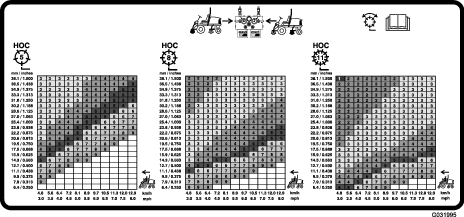
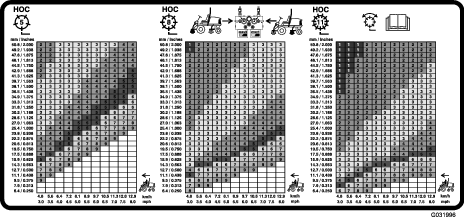
Adjusting the Lift-Arm Counterbalance
You can adjust the counterbalance on the rear cutting-unit lift arms to compensate for different turf conditions and to maintain a uniform height of cut in the rough conditions or in areas of thatch buildup.
You can adjust each counterbalance spring to 1 of 4 settings. Each increment increases or decreases counterbalance on the cutting unit by 2.3 kg (5 lb). You can position the springs on the back side of the first spring actuator to remove all counter balance (fourth position).
-
Park the machine on a level surface, lower the cutting units, engage the parking brake, shut off the engine, and remove the key.
-
Insert a tube or similar object onto the long spring end and pivot it around the spring actuator to the desired position (Figure 37).
Caution
The springs are under tension and could cause personal injury.
Use caution when adjusting the springs.
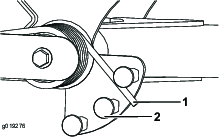
-
Repeat the procedure on the other spring.
Adjusting the Lift-Arm Turnaround Position
-
Park the machine on a level surface, lower the cutting units, engage the parking brake, shut off the engine, and remove the key.
-
The lift-arm switch is located underneath the hydraulic tank behind the front, right lift arm (Figure 38).
-
Loosen the switch-mounting screws and move the switch down to increase the lift-arm turnaround height or move the switch up to decrease the lift-arm turnaround height (Figure 38).
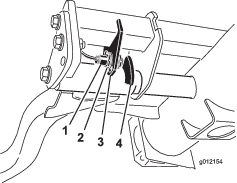
-
Tighten the mounting screws.
Understanding the Diagnostic Light
The machine is equipped with a diagnostic light, which indicates if the machine detects a malfunction. The diagnostic light is located on the InfoCenter, above the display screen (Figure 39). When the machine is functioning properly and the key switch is moved to the ON/RUN position, the diagnostic light turns on briefly to indicate that the light is working properly. When a machine advisory message appears, the light illuminates when the message is present. When a fault message appears, the light blinks until the fault is resolved.
Checking the Interlock Switches
The purpose of the interlock switches is to prevent the engine from cranking or starting unless the traction pedal is in the NEUTRAL position, the Enable/Disable switch is in the DISABLE position, and the Lower Mow/Raise control is in the NEUTRAL position. In addition, the engine should stop when you press the traction pedal while you are off the seat or if the parking brake is engaged.
Caution
If the safety-interlock switches are disconnected or damaged, the machine could operate unexpectedly, causing personal injury.
-
Do not tamper with the interlock switches.
-
Check the operation of the interlock switches daily and replace any damaged switches before operating the machine.
Verifying the Interlock-Switch Function
| Maintenance Service Interval | Maintenance Procedure |
|---|---|
| Before each use or daily |
|
-
Park the machine on a level surface, lower the cutting units, shut off the engine, engage the parking brake, and remove the key from the ignition switch.
-
Turn the key in the ignition switch to the ON position, but do not start the machine.
-
Locate the appropriate switch function in the diagnostics menu on the InfoCenter.
-
Individually, change each of the switches from open to closed (i.e., sit on seat, engage traction pedal, etc.), and note that the appropriate state of the switch changes.
Note: Repeat this for all switches that you can change by hand.
-
If a switch is closed and the appropriate indicator does not change, check all wiring and connections to the switch and/or check the switches with an ohm meter.
Note: Replace any faulty switches and repair any faulty wiring.
Note: The InfoCenter display also has the ability to detect which output solenoids or relays are turned on. This is a quick way to determine if a machine malfunction is electrical or hydraulic.
Verifying the Output Function
-
Park the machine on a level surface, lower the cutting units, shut off the engine, engage the parking brake, and remove the key from the ignition switch.
-
Turn the key in the ignition switch to the ON position and start the machine.
-
Locate the appropriate output function in the diagnostics menu on the InfoCenter.
-
Sit on the seat and attempt to operate the desired function of the machine.
Note: The appropriate outputs should change state to indicate that the ECM is turning on that function.If the correct outputs do not illuminate, verify that the required input switches are in the necessary positions to allow that function to occur. Verify the correct switch function.If the output displays are on as specified, but the machine does not function properly, this indicates a non-electrical problem. Repair the machine as necessary.
Operating Tips
Becoming Familiarized with the Machine
Before mowing grass, practice operating the machine in an open area. Start and shut off the engine. Operate in forward and reverse. Lower and raise the cutting units and engage and disengage the reels. When you feel familiar with the machine, practice operating up and down slopes at different speeds.
Understanding the Warning System
If a warning light comes on during operation, stop the machine immediately and correct the problem before continuing operation. Serious damage could occur if you operate the machine with a malfunction.
Mowing
Start the engine and move the engine-speed switch to the FAST position. Move the Enable/Disable switch to the ENABLE position and use the Lower Mow/Raise lever to control the cutting units (the front cutting units are timed to lower before the rear cutting units). To move forward and cut grass, press the traction pedal forward.
Transporting the Machine
Move the Enable/Disable switch to the DISABLE position and raise the cutting units to the TRANSPORT position. Move the Mow/Transport lever to the TRANSPORT position. Be careful when driving between objects so you do not accidentally damage the machine or cutting units. Use extra care when operating the machine on slopes. Drive slowly and avoid sharp turns on slopes to prevent rollovers. Lower the cutting units when going downhill for steering control.
After Operation
After Operation Safety
General Safety
-
Always shut off the engine, remove the key (if equipped), wait for all moving parts to stop, and allow the machine to cool before adjusting, servicing, cleaning, or storing the machine.
-
Clean grass and debris from the cutting units, drives, mufflers, cooling screens, and engine compartment to help prevent fires. Clean up oil or fuel spills.
-
Shut off the fuel while storing or transporting the machine.
-
Disengage the drive to the attachment whenever you are transporting or not using the machine.
-
Allow the engine to cool before storing the machine in any enclosure.
-
Maintain and clean the seat belt(s) as necessary.
-
Do not store the machine or fuel container where there is an open flame, spark, or pilot light, such as on a water heater or on other appliances.
Pushing or Towing the Machine
In an emergency, you can move the machine by actuating the bypass valve in the variable displacement hydraulic pump and pushing or towing the machine.
Important: Do not push or tow the machine faster than 3 to 4.8 km/h (2 to 3 mph) because internal transmission damage may occur. The bypass valve must be open whenever you push or tow the machine.
-
Rotate the bypass-valve bolt 1-1/2 turns to open and allow oil to bypass internally (Figure 40).
Note: The bypass valve is located on the left side of the hydrostat. By bypassing the fluid, you can move the machine slowly without damaging the transmission.

-
Close the bypass valve before starting the engine. However, do not exceed 7 to 11 N∙m (5 to 8 ft-lb) torque to close the valve.
Important: Running the engine with the bypass valve open causes the transmission to overheat.
Identifying the Tie-Down Points
Jacking Points
Note: Use jack stands to support the machine when required.
-
Front—rectangular pad, under the axle tube, inside each front tire (Figure 43).
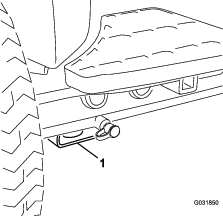
-
Rear—rectangular axle tube on the rear axle.
Hauling the Machine
-
Use full-width ramps for loading the machine onto a trailer or truck.
-
Tie the machine down securely.
Hydraulic-Valve Solenoid Functions
Use the list below to identify and describe the different functions of the solenoids in the hydraulic manifold. Each solenoid must be energized to allow the function to occur.
| Solenoid | Function |
|---|---|
| SVRV | Lift/lower cutting units |
| SV1 | Lift/lower front cutting unit |
| SV3 | Lift/lower rear cutting unit |
| SV2 | Raise any cutting units |
Maintenance
Note: Determine the left and right sides of the machine from the normal operating position.
Recommended Maintenance Schedule(s)
| Maintenance Service Interval | Maintenance Procedure |
|---|---|
| After the first hour |
|
| After the first 8 hours |
|
| After the first 10 hours |
|
| After the first 50 hours |
|
| Before each use or daily |
|
| Every 50 hours |
|
| Every 100 hours |
|
| Every 150 hours |
|
| Every 200 hours |
|
| Every 250 hours |
|
| Every 400 hours |
|
| Every 800 hours |
|
| Before storage |
|
| Every 2 years |
|
Pre-Maintenance Procedures
Maintenance Safety
-
Before adjusting, cleaning, servicing, or leaving the machine, do the following:
-
Park the machine on a level surface.
-
Move the throttle switch to the low-idle position.
-
Disengage the cutting units.
-
Lower the cutting units.
-
Ensure that the traction is in neutral.
-
Engage the parking brake.
-
Shut off the engine and remove the key.
-
Wait for all moving parts to stop.
-
Allow machine components to cool before performing maintenance.
-
-
If possible, do not perform maintenance while the engine is running. Keep away from moving parts.
-
Use jack stands to support the machine or components when required.
-
Carefully release pressure from components with stored energy.
-
Keep all parts of the machine in good working condition and all hardware tightened.
-
Replace all worn or damaged decals.
-
To ensure safe, optimal performance of the machine, use only genuine Toro replacement parts. Replacement parts made by other manufacturers could be dangerous, and such use could void the product warranty.
Lubrication
Greasing the Bearings and Bushings
| Maintenance Service Interval | Maintenance Procedure |
|---|---|
| Every 50 hours |
|
Lubricate all grease fittings for the bearings and bushings with No. 2 lithium grease.
The grease fitting locations and quantities are as follows:
-
Pump driveshaft U-joint (3) (Figure 44)
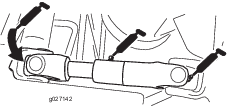
-
Cutting-unit lift-arm cylinders (2 each) (Figure 45)

-
Lift-arm pivots (1 each) (Figure 45)
-
Cutting-unit carrier-frame and pivot (2 each) (Figure 46)
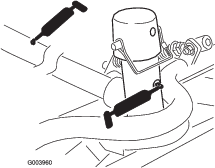
-
Lift-arm-pivot shaft (1 each) (Figure 47)
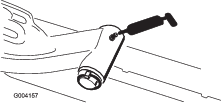
-
Rear axle tie rod (2) (Figure 48)
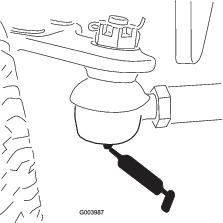
-
Axle-steering pivot (1) (Figure 49)

-
Steering-cylinder ball joints (2) (Figure 50)
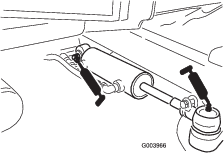
-
Brake pedal (1) (Figure 51)

Engine Maintenance
Engine Safety
-
Shut off the engine before checking the oil or adding oil to the crankcase.
-
Do not change the governor speed or overspeed the engine.
Servicing the Air Cleaner
| Maintenance Service Interval | Maintenance Procedure |
|---|---|
| Every 400 hours |
|
Check the air-cleaner body for damage which could cause an air leak. Replace if damaged. Check the whole intake system for leaks, damage, or loose hose clamps.
Service the air-cleaner filter only when the service indicator requires it (Figure 52). Changing the air filter before it is necessary only increases the chance of dirt entering the engine when you remove the filter.
Important: Make sure that the cover is seated correctly and seals with the air-cleaner body.
-
Park the machine on a level surface, lower the cutting units, engage the parking brake, shut off the engine, and remove the key.
-
Release the latches securing the air-cleaner cover to the air-cleaner body (Figure 52).
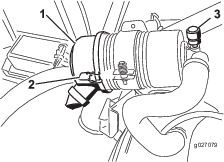
-
Remove the cover from the air-cleaner body.
-
Before removing the filter, use low-pressure air—275 kPa (40 psi), clean and dry—to help remove large accumulations of debris packed between outside of the filter and the canister.
Important: Avoid using high-pressure air, which could force dirt through the filter into the intake tract.
Note: This cleaning process prevents debris from migrating into the intake when you remove the filter.
-
Remove and replace the filter (Figure 53).
Note: Do not clean the used element due to the possibility of damaging the filter media.
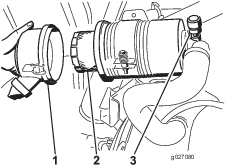
-
Inspect the new filter for shipping damage, checking the sealing end of the filter and the body.
Important: Do not use a damaged element.
-
Insert the new filter by applying pressure to the outer rim of the element to seat it in the canister.
Important: Do not apply pressure to the flexible center of the filter.
-
Clean the dirt-ejection port located in the removable cover. Remove the rubber outlet valve from the cover, clean the cavity, and replace the outlet valve.
-
Install the cover orienting the rubber outlet valve in a downward position—between approximately 5 o’clock to 7 o’clock when viewed from the end.
-
Secure the latches.
Servicing the Engine Oil and Filter
| Maintenance Service Interval | Maintenance Procedure |
|---|---|
| After the first 50 hours |
|
| Every 150 hours |
|
-
Remove the drain plug (Figure 54) and let the oil flow into a drain pan.
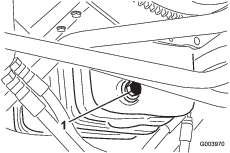
-
When all the oil is drained, install the drain plug.
-
Remove the oil filter (Figure 55).
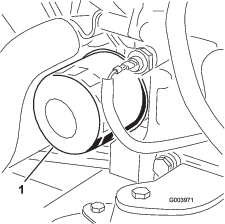
-
Apply a light coat of clean oil to the new filter seal.
-
Install the replacement oil filter to the filter adapter. Turn the oil filter clockwise until the rubber gasket contacts the filter adapter, then tighten the filter an additional 1/2 turn.
Important: Do not over-tighten the filter.
-
Add oil to the crankcase; refer to Checking the Engine-Oil Level.
Fuel System Maintenance
Danger
Under certain conditions, fuel and fuel vapors are highly flammable and explosive. A fire or explosion from fuel can burn you and others and can cause property damage.
-
Fill the fuel tank outdoors, in an open area, when the engine is off and is cold. Wipe up any fuel that spills.
-
Do not fill the fuel tank completely full. Add fuel to the fuel tank until the level is 25 mm (1 inch) below the top of the tank, not the filler neck. This empty space in the tank allows the fuel to expand.
-
Never smoke when handling fuel, and stay away from an open flame or where fuel fumes may be ignited by a spark.
-
Store fuel in a clean, safety-approved container and keep the cap in place.
Draining the Fuel Tank
| Maintenance Service Interval | Maintenance Procedure |
|---|---|
| Every 800 hours |
|
| Before storage |
|
Drain and clean the fuel tank if the fuel system becomes contaminated or if the machine is to be stored for an extended period. Use clean fuel to flush out the tank.
Checking the Fuel Lines and Connections
| Maintenance Service Interval | Maintenance Procedure |
|---|---|
| Every 400 hours |
|
Inspect the fuel lines for deterioration, damage, or loose connections.
Servicing the Water Separator
| Maintenance Service Interval | Maintenance Procedure |
|---|---|
| Before each use or daily |
|
| Every 400 hours |
|
-
Place a clean container under the fuel filter.
-
Loosen the drain plug on the bottom of the filter canister.
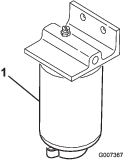
-
Clean the area where the filter canister mounts.
-
Remove the filter canister and clean the mounting surface.
-
Lubricate the gasket on the filter canister with clean oil.
-
Install the filter canister by hand until the gasket contacts the mounting surface, then rotate it an additional 1/2 turn.
-
Tighten the drain plug on the bottom of the filter canister.
Servicing the Fuel-Pickup Tube
The fuel-pickup tube, located inside the fuel tank, comes with a screen to help prevent debris from entering the fuel system. Remove the fuel-pickup tube and clean the screen as required.
Bleeding Air from the Fuel Injectors
Note: Perform this procedure only if the fuel system has been purged of air through normal priming procedures and the engine does not start; refer to Bleeding the Fuel System.
-
Loosen the pipe connection to the No. 1 nozzle and holder assembly (Figure 57).
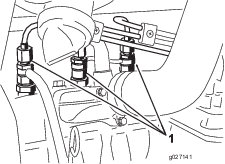
-
Turn the key in the ignition switch to the ON position and watch the fuel flow around the connector. When you observe a solid flow of fuel, turn the key to the OFF position.
-
Tighten the pipe connector securely.
-
Repeat steps 1 through 3 on the remaining nozzles.
Electrical System Maintenance
Important: Before welding on the machine, disconnect all cables from the battery, both wire harness plugs from the electronic control module, and the terminal connector from the alternator to prevent damage to the electrical system.
Electrical System Safety
-
Disconnect the battery before repairing the machine. Disconnect the negative terminal first and the positive last. Connect the positive terminal first and the negative last.
-
Charge the battery in an open, well-ventilated area, away from sparks and flames. Unplug the charger before connecting or disconnecting the battery. Wear protective clothing and use insulated tools.
Servicing the Battery
| Maintenance Service Interval | Maintenance Procedure |
|---|---|
| Every 50 hours |
|
Danger
Battery electrolyte contains sulfuric acid, which is fatal if consumed and causes severe burns.
-
Do not drink electrolyte and avoid contact with skin, eyes, or clothing. Wear safety glasses to shield your eyes and rubber gloves to protect your hands.
-
Fill the battery where clean water is always available for flushing the skin.
Warning
Charging the battery produces gasses that can explode.
Never smoke near the battery and keep sparks and flames away from it.
Keep the terminals and the entire battery case clean because a dirty battery discharges slowly. To clean the battery, wash the entire case with a solution of baking soda and water. Rinse it with clear water.
Replacing the Fuses
There are 8 fuses in the 12 V electrical system. The fuse block (Figure 58) is located behind the control-arm-access panel.
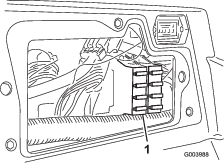
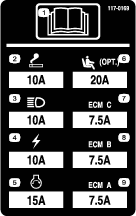
There are 6 fuses in the 48 V electrical system. 5 fuses are located in the fuse block (Figure 60) which is under the hood and behind the seat. The sixth fuse (Figure 61) is located under the black cover which is under the seat.
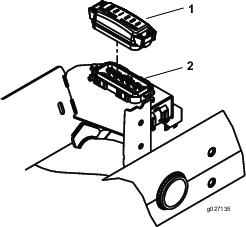
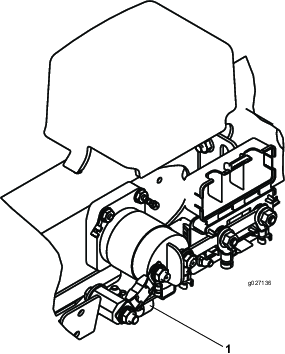

Drive System Maintenance
Adjusting the Traction Drive for Neutral
The machine must not creep when you release the traction pedal. If it does creep, adjust it as follows:
-
Park the machine on a level surface, lower the cutting units to the ground, shut off the engine, and remove the key.
-
Jack up the front of the machine until the front tires are off the ground. Support the machine with jack stands to prevent it from falling accidentally.
Note: On 4-wheel-drive models, the rear tires must also be off the ground.
-
On the right side of the hydrostat, loosen the locknut on the traction-adjustment cam (Figure 63).
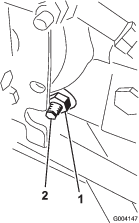
Warning
The engine must be running while you perform the final adjustment on the traction adjustment cam. This could cause personal injury.
Keep your hands, feet, face, and other body parts away from the muffler, other hot parts of the engine, and any rotating parts.
-
Start the engine and rotate the cam hex in either direction until the wheels stop rotating.
-
Tighten the locknut to secure the adjustment.
-
Shut off the engine, remove the jack stands, and lower the machine to the ground.
-
Test drive the machine to make sure that it does not creep.
Adjusting the Rear Wheel Toe-in
| Maintenance Service Interval | Maintenance Procedure |
|---|---|
| Every 800 hours |
|
-
Rotate the steering wheel to position the rear wheels straight ahead.
-
Loosen the jam nut on each end of the tie rod (Figure 64).
Note: The end of the tie rod with the external groove is a left-hand thread.
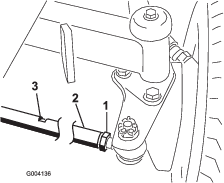
-
Using the wrench slot, rotate the tie rod.
-
Measure the distance at the front and rear of the rear wheels at axle height.
Note: The distance at the front of the rear wheels should be less than 6 mm (1/4 inch) of the distance measured at the rear of the wheels.
-
Repeat this procedure as required.
Cooling System Maintenance
Cooling System Safety
-
Swallowing engine coolant can cause poisoning; keep out of reach from children and pets.
-
Discharge of hot, pressurized coolant or touching a hot radiator and surrounding parts can cause severe burns.
-
Always allow the engine to cool at least 15 minutes before removing the radiator cap.
-
Use a rag when opening the radiator cap, and open the cap slowly to allow steam to escape.
-
Removing Debris from the Cooling System
| Maintenance Service Interval | Maintenance Procedure |
|---|---|
| Before each use or daily |
|
| Every 100 hours |
|
| Every 2 years |
|
-
Shut off the engine and remove the key from the ignition switch.
-
Thoroughly clean all debris out of the engine area.
-
Unlatch the clamp and pivot open the rear screen (Figure 65).
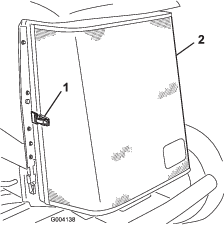
-
Clean the screen thoroughly with compressed air.
-
Pivot the latches inward to release the oil cooler (Figure 66).
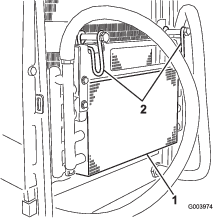
-
Thoroughly clean both sides of the oil cooler and the radiator (Figure 67) with compressed air.

-
Pivot the oil cooler back into position and secure the latches.
-
Close the screen and secure the latch.
Brake Maintenance
Adjusting the Parking Brakes
Adjust the brakes when there is more than 25 cm (1 inch) of free travel (Figure 68) of the brake pedal, or when more holding force is required. Free travel is the distance that the brake pedal moves before you feel braking resistance.
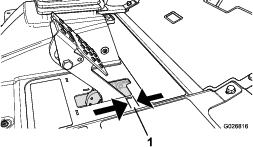
Note: Use the wheel motor backlash to rock the drums back and forth to ensure that the drums are free prior to and after adjustment.
-
To reduce free travel of the brake pedals, tighten the brakes by loosening the front nut on the threaded end of the brake cable (Figure 69).

-
Tighten the rear nut to move the cable backward until brake pedals have 6.3 to 12.7 mm (1/4 to 1/2 inch) of free travel (Figure 68), before the wheel locks up.
-
Tighten the front nuts, ensuring that both cables actuate the brakes simultaneously.
Note: Ensure that the cable conduit does not rotate while you are tightening the nuts.
Adjusting the Parking-Brake Latch
If the parking brake fails to engage and latch, an adjustment to the brake pawl is required.
-
Loosen the 2 screws securing the parking-brake pawl to the frame (Figure 70).

-
Press the parking-brake pedal forward until the brake detent completely engages on the brake pawl (Figure 70).
-
Tighten the 2 screws to lock the adjustment.
-
Press the brake pedal to release the parking brake.
-
Check the adjustment and adjust as required.
Belt Maintenance
Tensioning the Alternator Belt
| Maintenance Service Interval | Maintenance Procedure |
|---|---|
| After the first 8 hours |
|
| Every 100 hours |
|
-
Open the hood.
-
Check the tension of the alternator belt by depressing it (Figure 71) midway between the alternator and the crankshaft pulleys with 10 kg (22 lb) of force.
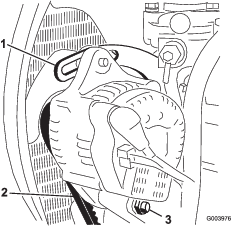
The belt should deflect 11 mm (7/16 inch). If the deflection is incorrect, proceed to step 3. If correct, continue operation.
-
Loosen the bolt securing the brace to the engine (Figure 71), the bolt securing the alternator to the brace and the pivot bolt.
-
Insert a pry bar between the alternator and the engine and pry out on the alternator.
-
When you achieve the proper tension, tighten the alternator, brace, and pivot bolts to secure the adjustment.
Hydraulic System Maintenance
Hydraulic System Safety
-
Seek immediate medical attention if fluid is injected into skin. Injected fluid must be surgically removed within a few hours by a doctor.
-
Ensure that all hydraulic-fluid hoses and lines are in good condition and all hydraulic connections and fittings are tight before applying pressure to the hydraulic system.
-
Keep your body and hands away from pinhole leaks or nozzles that eject high-pressure hydraulic fluid.
-
Use cardboard or paper to find hydraulic leaks.
-
Safely relieve all pressure in the hydraulic system before performing any work on the hydraulic system.
Changing the Hydraulic Fluid
| Maintenance Service Interval | Maintenance Procedure |
|---|---|
| Every 800 hours |
|
| Every 2 years |
|
If fluid becomes contaminated, contact your Toro Distributor because the system must be flushed. Contaminated fluid looks milky or black when compared to clean oil.
-
Park the machine on a level surface, lower the cutting units, shut off the engine, engage the parking brake, and remove the key.
-
Raise the hood.
-
Place a large drain pan under the fitting secured to the bottom of the hydraulic-fluid reservoir (Figure 72).
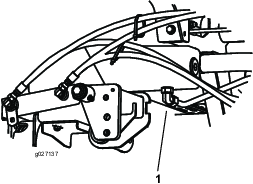
-
Disconnect the hose from the bottom of the fitting and let the hydraulic fluid flow into the drain pan.
-
Install the hose when hydraulic fluid stops draining.
-
Fill the reservoir with approximately 41.6 L (11 US gallons) of hydraulic fluid; refer to Checking the Hydraulic Fluid.
Important: Use only hydraulic fluids specified. Other fluids could damage the system.
-
Install the reservoir cap.
-
Start the engine and use all of the hydraulic controls to distribute hydraulic fluid throughout the system. Also, check for leaks.
-
Shut off the engine.
-
Check the level of the hydraulic fluid and add enough to raise level to the FULL mark on the dipstick.
Important: Do not overfill.
Replacing the Hydraulic Filter
| Maintenance Service Interval | Maintenance Procedure |
|---|---|
| Every 800 hours |
|
Important: Use of any other filters may void the warranty on some components.
-
Park the machine on a level surface, lower the cutting units, shut off the engine, engage the parking brake, and remove the key.
-
Clean the area around the filter-mounting area and place a drain pan under the filter (Figure 73).
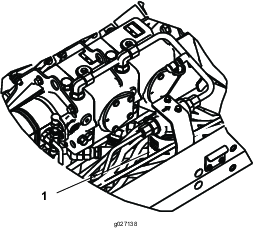
-
Remove the filter.
-
Lubricate the gasket on the new filter with hydraulic oil.
-
Ensure that the filter-mounting area is clean.
-
Install the filter by hand until the gasket contacts the mounting surface, then rotate it an additional 1/2 turn.
-
Start the engine and let it run for about 2 minutes to purge air from the system.
-
Shut off the engine and check for leaks.
Checking the Hydraulic Lines and Hoses
| Maintenance Service Interval | Maintenance Procedure |
|---|---|
| Before each use or daily |
|
Check the hydraulic lines and hoses for leaks, kinked lines, loose mounting supports, wear, loose fittings, weather deterioration, and chemical deterioration. Make all necessary repairs before operating.
Testing the Pressure in the Hydraulic System
Use the hydraulic system test ports to test the pressure in the hydraulic circuits. Contact your Toro Distributor for assistance.
Use the test ports on the front hydraulic tubes (Figure 74) to assist in troubleshooting the traction circuit.
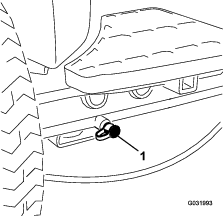
Use the test port on the gear pump (Figure 75) to assist in troubleshooting the lift circuit.
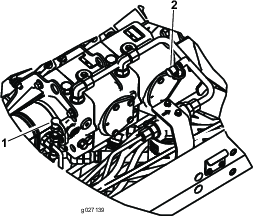
Use the test port on the hydraulic tube (Figure 75) to assist in troubleshooting the charge-pressure circuit.
Cutting Unit System Maintenance
Blade Safety
-
A worn or damaged blade or bedknife can break, and a piece could be thrown toward you or bystanders, resulting in serious personal injury or death.
-
Inspect the cutting units periodically for excessive wear or damage.
-
Use care when checking the cutting units. Wrap the blades or wear gloves, and use caution when servicing the reels and bedknives. Only replace or sharpen the reels and bedknives; never straighten or weld them.
-
On machines with multiple cutting units, take care when rotating a reel; it can cause the reels in the other cutting units to rotate.
Backlapping the Cutting Units
Note: When backlapping, the front units all operate together, and the rear units operate together.
-
Park the machine on a level surface, lower the cutting units, shut off the engine, engage the parking brake, and move the Enable/Disable switch to DISABLE position.
-
To activate the backlap function on the InfoCenter service menu, proceed as follows:
-
With the engine off, but the key in the run position, access the Main Menu of the InfoCenter.
-
From the Main Menu, scroll down to Service Menu using the center button and select it using the right button.
-
In the Service Menu, scroll down to Front Backlap, Rear Backlap, and activate front, rear or both by using the right button to turn the desired set of cutting units from OFF to ON.
-
Press the left button to save the settings and exit the Settings menu.
-
-
Make initial reel-to-bedknife adjustments appropriate for backlapping on all cutting units which are to be backlapped; refer to the cutting unit Operator's Manual.
-
Start the engine and run at low idle speed.
Danger
Changing the engine speed while backlapping may cause the reels to stall.
-
Never change the engine speed while backlapping.
-
Only backlap at idle engine speed.
-
-
With the Mow/Transport lever in the MOW position, move the Enable/Disable switch to the ENABLE position. Move the Lower Mow/Lift control forward to start the backlapping operation on the designated reels.
-
Apply lapping compound with a long-handled brush.
Important: Never use a short-handled brush.
-
If the reels stall or become erratic while backlapping, select a higher reel speed setting until the speed stabilizes, then return the reel speed to your desired speed. This can be done using the buttons on the InfoCenter.
-
To make an adjustment to the cutting units while backlapping, turn the reels off by moving the Lower Mow/Raise lever rearward; the Enable/Disable switch to the DISABLE position, and shut off the engine. After completing adjustments, repeat steps through .
-
Repeat the procedure for all cutting units you want to backlap.
-
When finished, turn off the backlap functions, using the buttons in the InfoCenter, and wash all lapping compound off the cutting units. Adjust cutting unit reel to bedknife as needed. Adjust the cutting unit reel speed to the desired mowing setting.
Important: If you do not return the backlap function to the OFF setting after backlapping, the cutting units do not raise or function properly.
Note: For a better cutting edge, run a file across the front face of the bedknife after lapping. This removes any burrs or rough edges that may have built up on the cutting edge.
Storage
Preparing the Traction Unit
-
Thoroughly clean the traction unit, cutting units, and engine.
-
Check the tire pressure. Inflate all traction unit tires to 83 to 103 kPa (12 to 15 psi).
-
Check all fasteners for looseness and tighten them as necessary.
-
Grease all grease fittings and pivot points. Wipe up any excess lubricant.
-
Lightly sand and use touch-up paint on painted areas that are scratched, chipped, or rusted. Repair any dents in the metal body.
-
Service the battery and cables as follows:
-
Remove the battery terminals (negative terminal first) from the battery posts.
-
Clean the battery, terminals, and posts with a wire brush and baking soda solution.
-
Coat the cable terminals and battery posts with Grafo 112X skin-over grease (Toro Part Number 505-47) or petroleum jelly to prevent corrosion.
-
Slowly recharge the battery every 60 days for 24 hours to prevent lead sulfation of the battery.
-
Preparing the Engine
-
Drain the engine oil from the oil pan and replace the drain plug.
-
Remove and discard the oil filter. Install a new oil filter.
-
Refill the oil pan with designated quantity of motor oil.
-
Start the engine and run it at idle speed for approximately 2 minutes.
-
Shut off the engine.
-
Flush the fuel tank with fresh, clean diesel fuel.
-
Check antifreeze protection and add a 50/50 solution of water and antifreeze as needed for expected minimum temperature in your area.
-
Secure all fuel-system fittings.
-
Thoroughly clean and service the air-cleaner assembly.
-
Seal the air-cleaner inlet and the exhaust outlet with weatherproof tape.
-
Check the antifreeze protection and add as needed for expected minimum temperature in your area.
